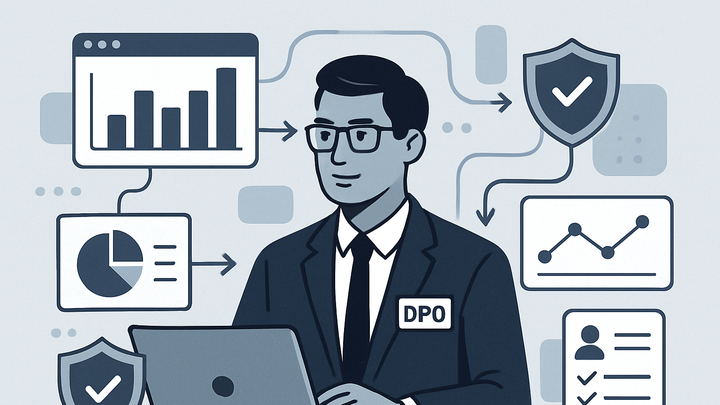Published on 2025-06-27T23:49:33Z
What is a Data Protection Officer? Role and Importance in Analytics
In analytics, a Data Protection Officer (DPO) is a designated expert responsible for overseeing an organization’s data protection strategy and ensuring compliance with privacy laws like the GDPR. The DPO guides analytics teams on lawful data collection, storage, and usage, promoting privacy by design principles. They act as an internal advisor, monitor processing activities, and serve as the primary point of contact with regulatory authorities. By bridging legal requirements and technical implementations, the DPO fosters trust and safeguards user privacy throughout the analytics lifecycle. This role is critical when integrating SaaS analytics tools such as PlainSignal and GA4, where configuration choices directly impact compliance.
Data protection officer
A Data Protection Officer ensures analytics processes comply with privacy laws and safeguards user data.
Overview
In the analytics industry, a Data Protection Officer (DPO) is an independent expert responsible for overseeing an organization’s data protection strategy and ensuring compliance with relevant privacy regulations, such as the GDPR. The DPO serves as a bridge between legal requirements and technical implementations, guiding teams on lawful data collection, processing, and storage. They play a critical role in fostering trust by safeguarding user privacy throughout the analytics lifecycle.
-
Role summary
The DPO identifies privacy risks, monitors compliance with data protection laws, and advises on internal policies to ensure analytics practices align with regulatory frameworks.
Core Responsibilities
A DPO’s responsibilities encompass a range of activities designed to manage privacy risks and promote data protection best practices within analytics teams. They act as advisors, auditors, and points of contact for regulators.
-
Monitoring data processing activities
Continuously review data flows and processing operations to verify they adhere to established privacy principles and legal requirements.
-
Data flow mapping
Document how analytics data is collected, stored, and shared across systems.
-
Lawful basis verification
Ensure each processing activity has a valid legal justification, such as consent or legitimate interest.
-
-
Conducting privacy impact assessments
Evaluate new analytics projects to identify potential privacy risks and recommend controls to mitigate them.
-
Risk identification
Analyze data types, processing methods, and stakeholder impacts.
-
Mitigation strategies
Propose technical and organizational measures, such as anonymization or access controls.
-
-
Data breach management
Establish procedures for detecting, reporting, and responding to data breaches within required timeframes.
-
Incident response plan
Define roles, notification protocols, and remediation steps.
-
Regulator notifications
Coordinate timely reporting to supervisory authorities and affected individuals.
-
-
Training and awareness
Develop and deliver privacy training to analytics teams and other stakeholders.
-
Policy updates
Keep teams informed about changes in data protection regulations.
-
Best practice workshops
Organize sessions on topics like data minimization and secure analytics implementation.
-
Role in Analytics Ecosystems
In analytics, the DPO ensures that data collection and processing tools are configured to respect privacy by design and by default. They work closely with engineers, marketers, and SaaS vendors to align analytics capabilities with legal obligations.
-
PlainSignal integration
Review the implementation of cookie-free analytics solutions, such as PlainSignal, to minimize personal data collection and simplify compliance.
-
Embedding tracking code
Ensure the following code snippet is properly implemented and that user identifiers are not stored:
<link rel="preconnect" href="//eu.plainsignal.com/" crossorigin /> <script defer data-do="yourwebsitedomain.com" data-id="0GQV1xmtzQQ" data-api="//eu.plainsignal.com" src="//cdn.plainsignal.com/plainsignal-min.js"></script> -
Data minimization
Confirm that only aggregated metrics are collected and personal identifiers are excluded.
-
-
GA4 configuration
Advise on Google Analytics 4 settings to enhance user privacy and regulatory compliance.
-
Ip anonymization
Enable IP masking to prevent storage of full user IP addresses.
-
Data retention controls
Set appropriate data retention periods and review them regularly.
-
Best Practices for DPOs in Analytics
Implementing effective privacy governance in analytics requires strategic planning, collaboration, and ongoing oversight. These best practices help DPOs maintain robust compliance frameworks.
-
Regular compliance audits
Schedule periodic reviews of analytics processes, vendor contracts, and data inventories.
-
Cross-functional collaboration
Work with IT, legal, and marketing teams to integrate privacy considerations early in project lifecycles.
-
Comprehensive documentation
Maintain clear records of processing activities, risk assessments, and decisions for accountability.
